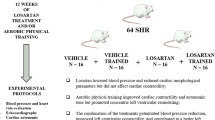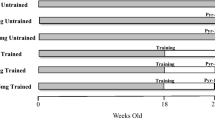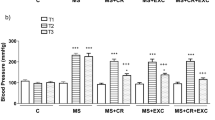Abstract
The aim of this work was to evaluate the influence of run training on the responsiveness of corpus cavernosum (CC) from rats made hypertensive by treatment with nitric oxide (NO) synthesis inhibitor. Wistar rats were divided into sedentary control (C-SD), exercise training (C-TR), Nω-nitro-L-arginine methyl ester (L-NAME) sedentary (LN-SD) and L-NAME trained (LN-TR) groups. The run training program consisted in 8 weeks in a treadmill, 5 days/week, each session lasted 60 min. L-NAME treatment (2 and 10 mg/rat/day) started after 4 weeks of prior physical conditioning and lasted 4 weeks. Concentration–response curves were obtained for acetylcholine (ACh), sodium nitroprusside (SNP), sildenafil and BAY 41-2272. The effect of electrical field stimulation (EFS) on the relaxations responses of CC was evaluated. Run training prevented the arterial hypertension induced by L-NAME treatment (LN-SD: 135±2 and 141±2 mm Hg for both doses of L-NAME) compared to LN-SD groups (154±1 and 175±2 mm Hg, for 2 and 10 mg of L-NAME, respectively). Run training produced an increase in the maximal responses (Emax) of CC for ACh (C-SD: 47±3; C-TR: 52±1; and LN-TR: 53±3%) and SNP (C-SD: 89±1; C-TR: 98±1; and LN-TR: 95±1%). Both potency and Emax for ACh were reduced in a dose of 10 mg of L-NAME, and run training restored the reduction of Emax for ACh. No changes were found for BAY 41-2271 and sildenafil. Relaxing responses to EFS was reduced by L-NAME treatment that was restored by prior physical conditioning. In conclusion, our study shows a beneficial effect of prior physical conditioning on the impaired CC relaxing responses in rats made hypertensive by chronic NO blockade.
This is a preview of subscription content, access via your institution
Access options
Subscribe to this journal
Receive 8 print issues and online access
$259.00 per year
only $32.38 per issue
Buy this article
- Purchase on Springer Link
- Instant access to full article PDF
Prices may be subject to local taxes which are calculated during checkout



Similar content being viewed by others
References
Delp MD, McAllister RM, Laughlin MH . Exercise training alters endothelium-dependent vasoreactivity of rat abdominal aorta. J Appl Physiol 1993; 75: 1354–1363.
Wang J, Wolin MS, Hintze TH . Chronic exercise enhances endothelium-mediated dilation of epicardial coronary artery in conscious dogs. Circ Res 1993; 73: 829–838.
Sessa WC, Pritchard K, Seyedi N, Wang J, Hintze TH . Chronic exercise in dogs increases coronary vascular nitric oxide production and endothelial cell nitric oxide synthase gene expression. Circ Res 1994; 74: 349–353.
Shen W, Lundborg M, Wang J, Stewart JM, Xu X, Ochoa M et al. Role of EDRF in the regulation of regional blood flow and vascular resistance at rest and during exercise in conscious dogs. J Appl Physiol 1994; 77: 165–172.
Woodman CR, Muller JM, Laughlin MH, Price EM . Induction of nitric oxide synthase mRNA in coronary resistance arteries isolated from exercise-trained pigs. Am J Physiol 1997; 273: H2575–H2579.
Kingwell BA . Nitric oxide-mediated metabolic regulation during exercise: effects of training in health and cardiovascular disease. FASEB J 2000; 14: 1685–1696.
Lesniak KT, Dubbert PM . Exercise and hypertension. Curr Opin Cardiol 2001; 16: 356–359.
Muller SC, el-Damanhoury H, Ruth J, Lue TF . Hypertension and impotence. Eur Urol 1991; 19: 29–34.
Aranda P, Ruilope LM, Calvo C, Luque M, Coca A, Gil de Miquel A . Erectile dysfunction in essential arterial hypertension and effects of sildenafil: results of a Spanish national study. Am J Hypertens 2004; 17: 139–145.
Rajfer J, Aronson WJ, Bush PA, Dorey FJ, Ignarro LJ . Nitric oxide as a mediator of relaxation of the corpus cavernosum in response to nonadrenergic, noncholinergic neurotransmission. N Engl J Med 1992; 326: 90–94.
Andersson KE, Wagner G . Physiology of penile erection. Physiol Rev 1995; 75: 191–236.
Bivalacqua TJ, Champion HC, Hellstrom WJ, Kadowitz PJ . Pharmacotherapy for erectile dysfunction. Trends Pharmacol Sci 2000; 21: 484–489.
Andersson KE . Pharmacology of penile erection. Pharmacol Rev 2001; 53: 417–450.
Burnett AL . Nitric oxide in the penis: physiology and pathology. Am J Urol 1997; 157: 320–424.
Claudino MA, Priviero FBM, Teixeira CE, De Nucci G, Antunes E, Zanesco A . Improvement in relaxation response in corpus cavernosum from trained rats. Urology 2004; 63: 1004–1008.
Priviero FBM, De Nucci G, Antunes E, Zanesco A . Chronotropic response to adenosine receptor agonists in rat right atria after run training. Clin Exp Pharmacol Physiol 2004; 31: 741–743.
Ribeiro MO, Antunes E, De Nucci G, Lovisolo SM, Zatz R . Chronic inhibition of nitric oxide synthesis: a new model of arterial hypertension. Hypertension 1992; 20: 298–303.
Zatz R . A low cost tail-cuff method for the stimulation of mean arterial pressure in conscious rats. Lab Animal Sci 1990; 40: 198–201.
Grimm Jr RH, Grandits GA, Prineas RJ, McDonald RH, Lewis CE, Flack JM et al. Long-term effects on sexual function of five antihypertensive drugs and nutritional hygienic treatment in hypertensive men and women. Hypertension 1997; 29: 814–828.
Lennon SL, Quindry JC, French JP, Kim S, Mehta JL, Powers SK . Exercise and myocardial tolerance to ischaemia–reperfusion. Acta Physiol Scand 2004; 182: 161–169.
Esposito K, Giugliano F, Di Palo C, Giugliano G, Marfella R, D'Andrea F et al. Effect of lifestyle changes on erectile dysfunction in obese men. JAMA 2004; 291: 2978–2984.
Mombouli JV, Nakashima M, Hamra M, Vanhoutte PM . Endothelium-dependent relaxation and hyperpolarization evoked by bradykinin in canine coronary arteries: enhancement by exercise-training. Br J Pharmacol 1996; 117: 413–418.
Krieger EM, Brum PC, Negrão CE . Role of arterial baroreceptor function on cardiovascular adjustments to acute and chronic dynamic exercise. Biol Res 1998; 31: 273–279.
Tatchum-Talom R, Schulz R, McNeill JR, Khadour FH . Upregulation of neuronal nitric oxide synthase in skeletal muscle by swimming training. Am J Physiol 2000; 279: H1757–H1766.
Kuru O, Senturk UK, Demir N, Yesilkaya A, Erguler G, Erkilic M . Effect of exercise on blood pressure in rats with chronic NOS inhibition. Eur J Appl Physiol 2002; 87: 134–140.
Hambrecht R, Adams V, Erbs S, Linke A, Krankel N, Shu Y et al. Regular physical activity improves endothelial function in patients with coronary artery disease by increasing phosphorylation of endothelial nitric oxide synthase. Circulation 2003; 107: 3152–3158.
Xiao DS, Qian ZM . Plasma nitric oxide and iron concentration in exercise rats are negatively correlated. Mol Cell Biochem 2000; 208: 163–166.
Qian ZM, Xiao S, Ke Y, Liao QK . Increase nitric oxide is one of the causes of changes of iron metabolism in strenuously exercised rats. Am J Physiol 2001; 280: R739–R743.
Banfi G, Malavazos A, Iorio E, Dolci A, Doneda L, Verna R et al. Plasma oxidative stress biomarkers, nitric oxide and heat shock protein 70 in trained elite soccer players. Eur J Appl Physiol 2006; 96: 483–486.
Stasch JP, Becker EM, Alonso-Alija C, Apeler H, Dembowsky K, Feurer A et al. NO-independent regulatory site on soluble guanylate cyclase. Nature 2001; 410: 212–215.
Baracat JS, Teixeira CE, Okuyama CE, Priviero FBM, Faro R, Antunes E et al. Relaxing effects induced by the soluble guanylyl cyclase stimulator BAY 41-2272 in human and rabbit corpus cavernosum. Eur J Pharmacol 2003; 477: 163–169.
Bischoff E, Schramm M, Straub A, Feurer A, Stasch JP . BAY 41-2272: a stimulator of soluble guanylyl cyclase induces nitric oxide dependent penile erection in vivo. Urology 2003; 61: 464–467.
Kalsi JS, Rees RW, Hobbs AJ, Royle M, Kell PD, Ralph DJ et al. BAY41-2272, a novel nitric oxide independent soluble guanylyl cyclase activator, relaxes human and rabbit corpus cavernosum in vitro. J Urol 2003; 169: 761–766.
Gemalmaz H, Waldeck K, Chapman TN, Tuttle JB, Steers WD, Andersson KE . In vivo and in vitro investigation of the effects of sildenafil on rat cavernous smooth muscle. J Urol 2001; 165: 1010–1014.
Acknowledgements
We are grateful to Fundação de Amparo a Pesquisa do Estado de São Paulo (FAPESP) and Fundação para o desenvolvimento da UNESP (FUNDUNESP) for financial support.
Author information
Authors and Affiliations
Corresponding author
Rights and permissions
About this article
Cite this article
Claudino, M., Priviero, F., Camargo, E. et al. Protective effect of prior physical conditioning on relaxing response of corpus cavernosum from rats made hypertensive by nitric oxide inhibition. Int J Impot Res 19, 189–195 (2007). https://doi.org/10.1038/sj.ijir.3901511
Received:
Revised:
Accepted:
Published:
Issue Date:
DOI: https://doi.org/10.1038/sj.ijir.3901511



